How to prepare for your fingerprinting appointment: You’ll need a valid government-issued photo ID and any required forms from your requesting organization.
Schedule your appointment 2-3 weeks in advance, choosing weekday slots to avoid peak times. Start moisturizing your hands three days before, but skip lotions on appointment day.
You’ll want to arrive 10-15 minutes early with all documents and payment ready. Wear comfortable clothing with sleeves that easily roll up, and keep your hands clean but free of oils or chemicals.
Following these essential steps will set you up for a successful fingerprinting session, but there’s much more to weigh for ideal results.
Key Takeaways
- Gather all required documents including government-issued photo ID, fingerprinting authorization form, and appointment confirmation before your scheduled time.
- Moisturize hands daily for three days before the appointment, but avoid lotions and oils on the actual day.
- Schedule your appointment 2-3 weeks in advance and choose weekday slots to avoid peak hours and long wait times.
- Keep hands clean and avoid harsh chemicals or excessive washing 48 hours before fingerprinting to ensure clear, readable prints.
- Arrive on time with proper payment method and follow the technician’s instructions carefully during the fingerprinting process.
Required Documents and Identification
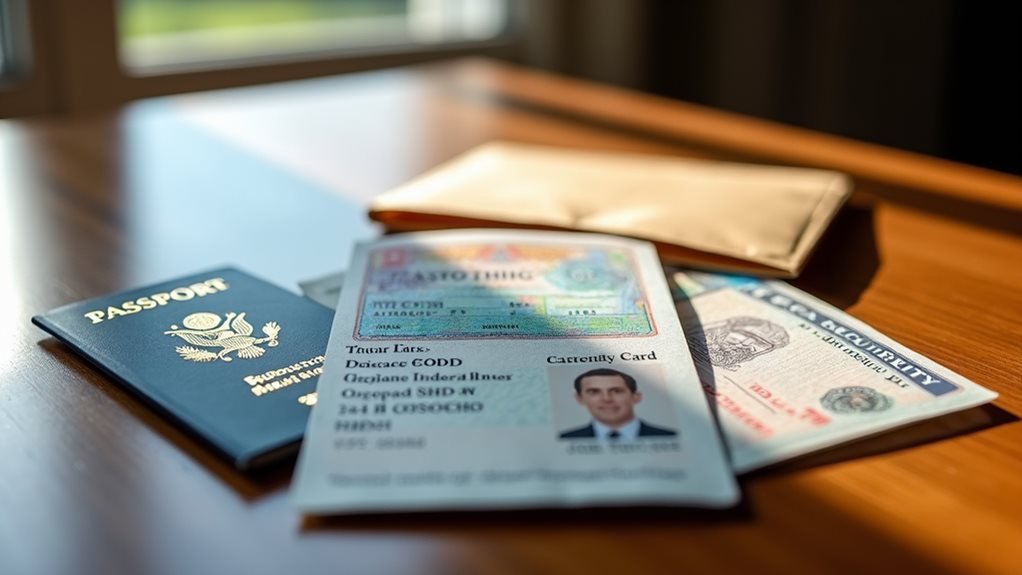
Two essential documents are required for your fingerprinting appointment: a valid government-issued photo ID and your fingerprinting authorization form.
Your ID must be current and include unique identifiers such as your full name, date of birth, and photograph. Acceptable forms include a driver’s license, passport, or state ID card.
Citizenship requirements vary depending on the purpose of your fingerprinting. If you’re not a U.S. citizen, bring your permanent resident card, work visa, or other relevant immigration documents.
Make sure your fingerprinting authorization form matches the name on your ID exactly. Any discrepancies could delay your appointment or require rescheduling. It’s also helpful to bring your appointment confirmation email or number, though this isn’t always mandatory.
Types of Fingerprinting Services
Once you’ve gathered your required documents, you’ll need to choose from several fingerprinting methods available today.
Different agencies and organizations require specific types of fingerprinting services depending on your needs, whether for Criminal Background checks or Immigration Purposes.
- Digital (Live Scan) Fingerprinting: This modern method captures your fingerprints electronically, offering quick processing and high accuracy. Results typically arrive within 24-72 hours.
- Ink-and-Roll (Traditional): This manual method involves rolling each finger in ink and pressing it onto a fingerprint card. It’s still commonly used for certain government applications and FBI background checks.
- Mobile Fingerprinting: Professional technicians come to your location with portable equipment, offering convenience for group services or those with mobility challenges.
Scheduling Your Appointment
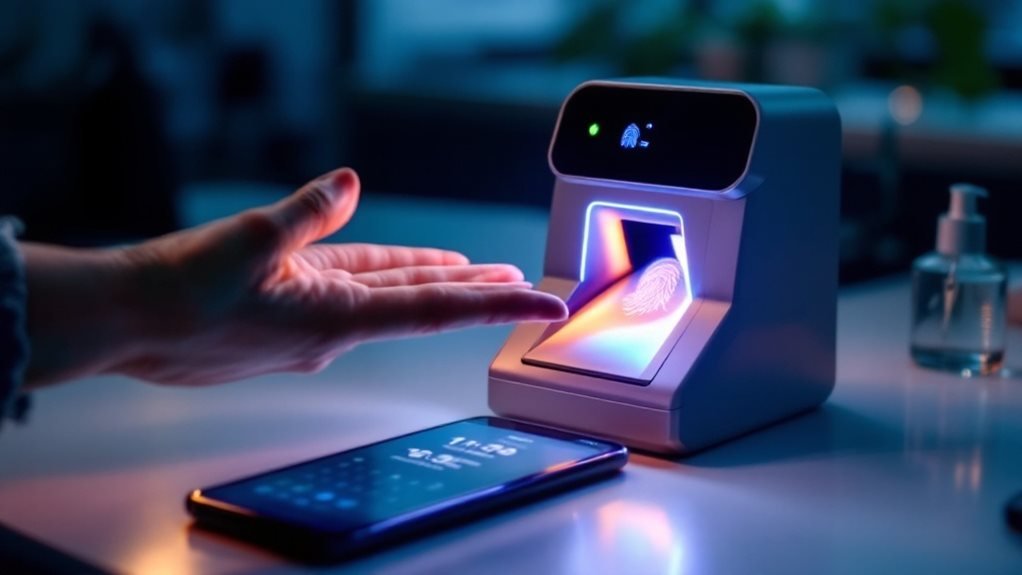
Securing your fingerprinting appointment requires advance planning and careful attention to scheduling options. Most providers offer online booking systems that let you choose your preferred date and time. You’ll need to weigh peak hours and availability at your chosen location.
| Scheduling Tips | Best Times | What to Avoid |
|---|---|---|
| Book 2-3 weeks ahead | Early mornings | Holiday periods |
| Choose weekdays | Mid-afternoon | Month-end rush |
| Check cancellation policy | Late weekday slots | Lunch hours |
| Set calendar reminders | Saturday mornings | Last appointment |
When scheduling your appointment, you’ll need to provide basic information including your name, contact details, and the purpose of fingerprinting. Some providers require prepayment during online booking, while others accept payment at the time of service. Remember to save your confirmation email and appointment details for reference.
Hand Care Before Fingerprinting
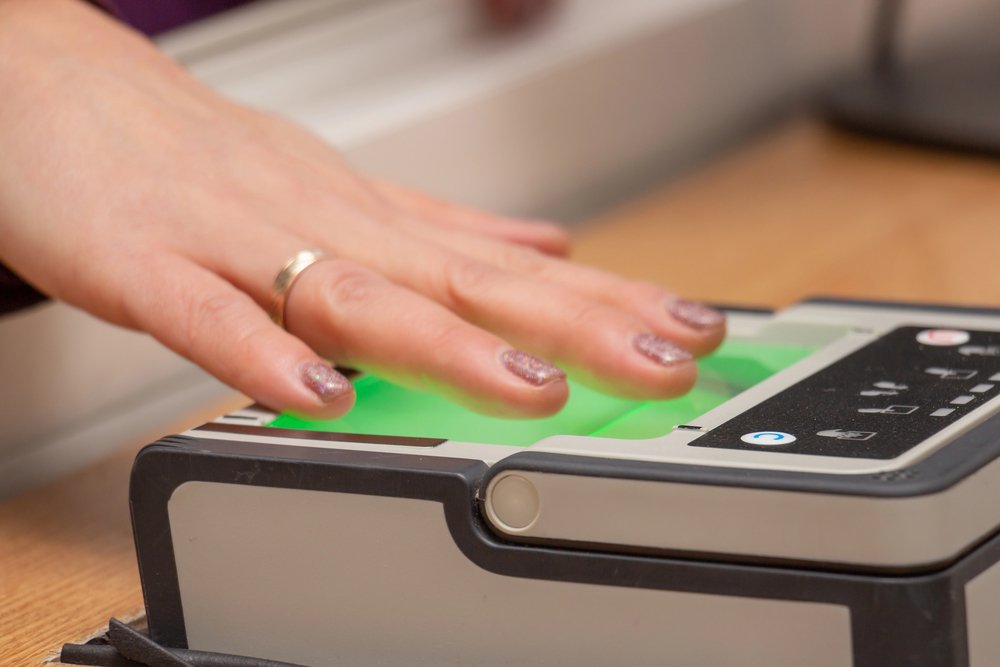 Preparing your hands properly before fingerprinting helps guarantee clear, accurate prints and a smooth appointment process.
Preparing your hands properly before fingerprinting helps guarantee clear, accurate prints and a smooth appointment process.
Proper skin preparation secures that your fingerprint ridges are distinct and easily readable by scanning equipment.
For the best results, follow these essential hand care steps:
- Moisturize your hands daily for at least three days before your appointment, focusing on hand moisturizing in the evening to let the product absorb overnight.
- Avoid harsh chemicals, excessive washing, or activities that could damage your fingerprints in the 48 hours before your appointment.
- On the day of fingerprinting, keep your hands clean but skip applying lotions or oils, as these can interfere with the scanning process and create smudged or unclear prints.
What to Wear
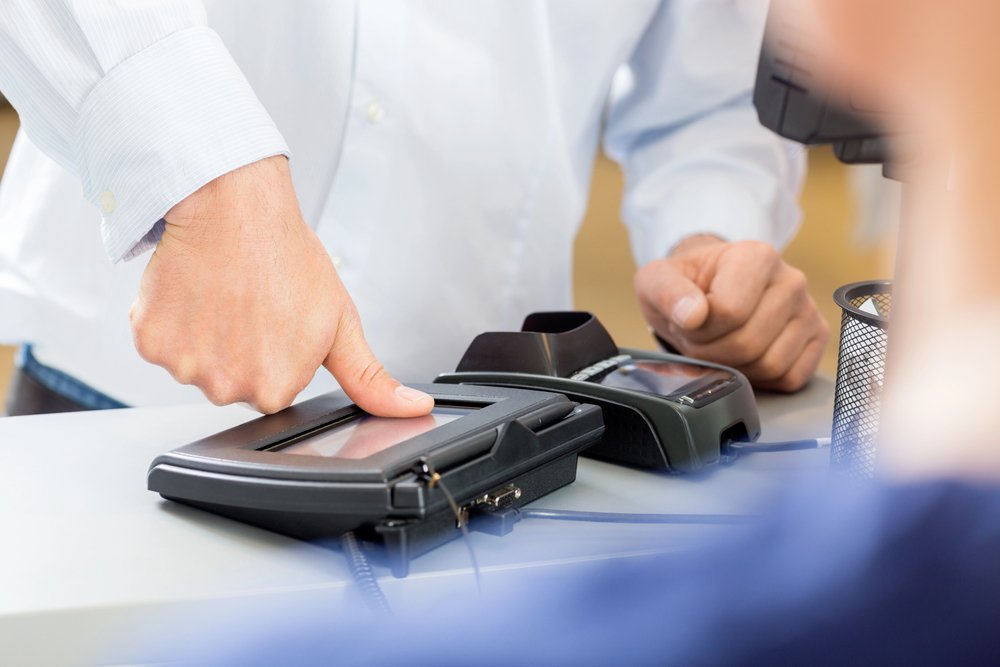
Beyond proper hand care, your choice of attire can considerably impact the fingerprinting process. When considering your fingerprint attire, opt for comfortable clothing that won’t interfere with the procedure. The dress code is typically casual but professional.
| Clothing Item | Recommendation |
|---|---|
| Sleeves | Short or easily rolled up |
| Jewelry | Minimal or none |
| Accessories | Avoid bulky items |
You’ll need easy access to your hands and fingers, so wear shirts with shorter sleeves or ones that can be easily pushed up. Remove any jewelry that might get in the way, especially rings and bracelets. Dress in layers if you’re unsure about the facility’s temperature, but guarantee your outer layer can be easily removed during the fingerprinting process.
Cost and Payment Methods
The financial aspect of fingerprinting services varies widely depending on your location and purpose. Fingerprinting costs typically range from $25 to $100 per session, with additional fees possible for rush processing or special handling.
Most facilities accept multiple payment options to make the process convenient for you. Here are the common payment methods accepted at fingerprinting locations:
- Credit or debit cards (Visa, Mastercard, American Express)
- Money orders or cashier’s checks made payable to the fingerprinting facility
- Cash payments (though some locations are cashless)
You’ll need to verify the exact cost and accepted payment methods when scheduling your appointment. Some employers may reimburse your fingerprinting expenses, so remember to keep your receipt.
Government agencies occasionally offer reduced fees for certain services or eligible individuals.
Common Reasons for Print Rejection
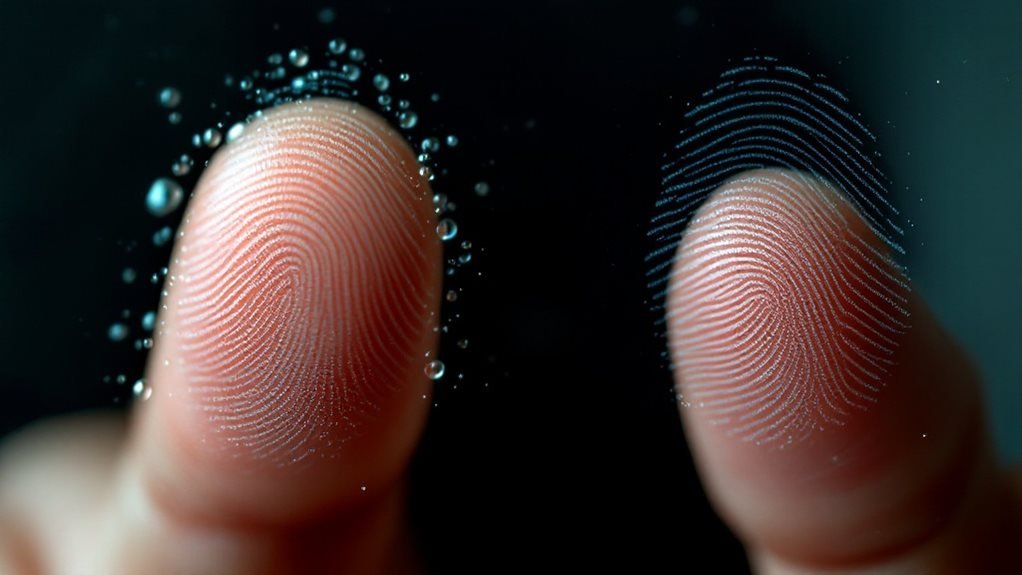
While securing proper payment guarantees you can proceed with your fingerprinting session, understanding why prints get rejected can save you time and money in the long run.
The most common reason for rejection is fingerprint smudging, which occurs when you move your fingers during the printing process or apply too much pressure on the scanner or card.
Incomplete impressions are another frequent issue that leads to rejection. This happens when you don’t roll your fingers properly from nail to nail or fail to press down with consistent pressure.
Dry, cracked, or worn fingerprints, often found among construction workers, mechanics, or those who frequently work with chemicals, can also cause rejections.
Additionally, cuts, scars, or bandages on your fingertips will prevent clear prints from being captured.
During Your Appointment Process
Making your appointment run smoothly involves three key steps you’ll encounter when you arrive. The average Waiting Time is typically 15-20 minutes, so plan accordingly.
During this time, you’ll need to complete any remaining paperwork and verify your identification documents.
- You’ll meet with a Technician who’ll explain the fingerprinting process and answer any questions you might have
- During the Technician Interaction, you’ll be guided through proper hand positioning and rolling techniques to guarantee quality prints
- The technician will capture your prints using either traditional ink methods or digital scanning equipment, documenting both flat impressions and rolled fingerprints.
Remember to follow the technician’s instructions carefully and maintain relaxed hands throughout the process. If needed, they’ll assist you in adjusting your positioning to get the clearest possible prints.
Results and Processing Time
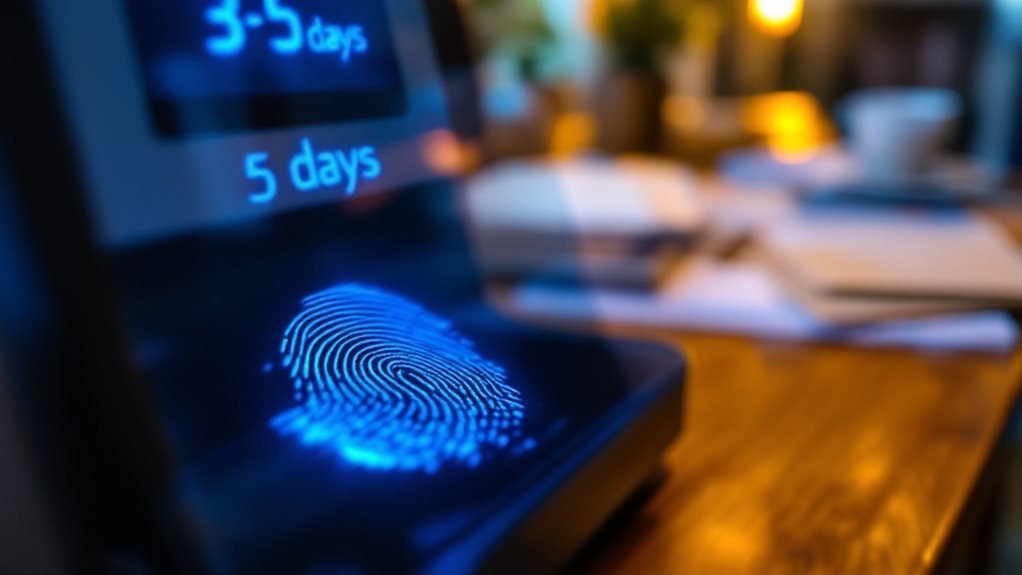
After completing the fingerprinting process, you’ll want to understand what happens next with your prints.
Your fingerprints are securely transmitted to the appropriate agencies for processing, which typically includes state and federal databases for background checks.
Result timelines vary depending on the purpose of your fingerprinting and the requesting organization.
Most fingerprint processing takes between 24-72 hours for electronic submissions, while manual card submissions may take 5-10 business days.
If you’re fingerprinted for employment, your employer will receive the results directly. For licensing or certification purposes, results go to the requesting agency.
You can usually track your fingerprint status online using your transaction number. If you haven’t received results within the expected timeframe, contact the requesting agency rather than the fingerprinting facility.
Frequently Asked Questions
Can I Get Fingerprinted if I Have a Cut or Bandage?
You’ll need to wait until your cut heals completely for accurate fingerprinting. Focus on proper wound care and skin preparation. If you must wear a bandage, contact the facility beforehand to discuss rescheduling options.
Do I Need to Wash My Hands Immediately Before the Fingerprinting Process?
No need to bring your own soap and towels While hand preparation is important, you don’t need to wash right before. Just make certain your hands are reasonably clean and free from excessive dirt or grease.
What Happens if I Am Physically Unable to Provide Fingerprints?
If you’re unable to provide fingerprints, don’t worry. You can request special accommodations from the agency. They’ll typically offer alternative methods like palm prints or facial recognition to complete your identification requirements.
Are Fingerprint Records Permanently Stored in the System?
Yes, your fingerprints will be kept in permanent storage once they’re captured. The FBI maintains fingerprint retention in their database indefinitely, though you can request removal in specific circumstances like wrongful arrests or court orders.
Can I Request Copies of My Fingerprints for Personal Records?
Like your unique signature in life, your personal fingerprints belong to you. You can request copies from the agency that took them, though they’ll need proper identification and may charge a fee for fingerprint storage access.
Conclusion
You’re almost ready for your big fingerprinting day While the process might seem intimidating, following these preparation tips will measurably boost your chances of success. Don’t let a rejected print delay your career goals, background check, or licensure requirements. Remember – clean hands, proper documentation, and arriving early are your keys to a smooth experience. Now, it’s time to make your mark, literally

